The Brazilian Rainbow Boa, as their colorful name might imply, is one of the most stunningly beautiful snakes in the world.
A Rainbow Boa’s base colors ranges from orange to a deep red. He comes with a variety of dark spotted and striped patterns, but what gives this creature his name, is his highly iridescent glow that seems to give off every color of the rainbow.
This snake can grow up to between five to six feet in size, with some even growing up to six and a half feet.
They have relatively easy care requirements as they are not overly picky about their temperatures or lighting, and they only eat once a week. However, their temperament is not as attractive as their appearance, as they can be rather shy and aggressive, so they are not the best pet for beginners.
If you are ready to handle a shy, albeit beautiful snake, then continue to read to learn about their husbandry and how to care for your new pet.
Brazilian Rainbow Boa Overview
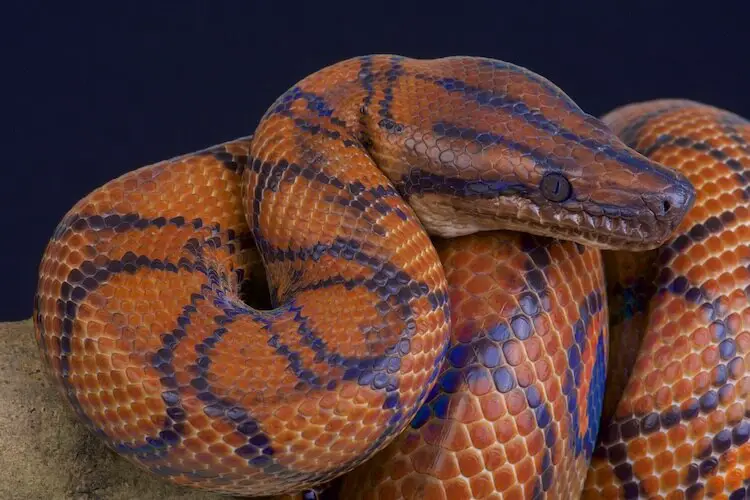
Reptile owners love this boa for its unique, scaly gleam. The orange-red hue contrasts their dark brown-black spots and stripes, and the iridescent glow is what gives the snake its name.
They have a relatively easy care routine because they only eat once a week and have relatively minimal lighting and heating requirements. They eat either mice and rats, and generally spend most of their time hiding in solitude.
The Rainbow Boa, despite its specific name, is distributed throughout South and Central America. There are multiple species of Rainbow Boas under the scientific family genus Epicrates and has nine subspecies:
- E. c. cenchria
- E. c. maurus
- E. c. alvaresi
- E. c. crassus
- E. c. barbouri
- E. c. gaigei
- E. c. polylepis
- E. c. hygrophilus
- E. c. assisi
In the wild you will find these creatures on low hanging branches or on the ground. They like the heat and high-humidity levels, so many can be found in the Amazon Rainforest.
They are a solitary snake, and they rarely confront each other except during breeding season. Because of their naturally shy temperament they prefer not to be handled under two years of age. They also do not enjoy being with other cage-mates.
| Summary Table | |
|---|---|
| Common Names | Brazilian Rainbow Boa, Slender Boa |
| Scientific Name | Epicrates cenchria |
| Adult Size | Five to six feet and upto 4,000 grams |
| Lifespan | 20 years |
| Diet | Large-sized mice and rats (dead and thawed) |
| Tank Size | 6 x 2 x 2 feet long vivarium |
| Temperature | 72℉ to 82℉ |
| Popular Alternatives | Ball Python, Sand Boa, Rosy Boa, Dumeril’s Boa |
Care & Husbandry Guide
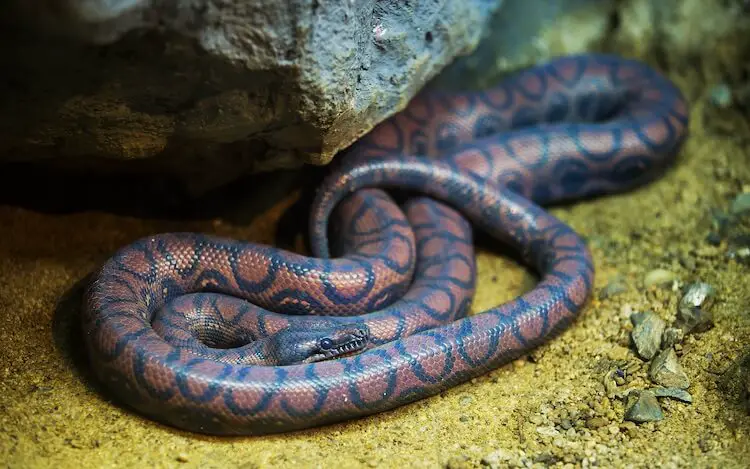
The natural habitat of the Brazilian Rainbow Boa is forests, rocky areas, and plantations. The climate in much of Central and South America is hot and humid, especially where this boa lives.
You will often find this snake in solitude, hanging from low branches or slithering on the ground. They can be active day or night, but they are most likely to be active in the evening and night-time.
Housing Requirements
A Rainbow Boa will thrive best in an enclosure that is at least 6 x 2 x 2 feet long. Glass or plastic terrariums work well, as well as a plasticized blackboard base.
Baby boas are best placed in a 32 quart plastic bin and should be moved into larger enclosures in accordance with their growth rate.
This pet is very shy, so they would rather be left alone and hide. Make sure you include atleast one hide in their enclosure.
Some owners find it best to provide some logs or branches so they can comfortably rest. They have even been known to enjoy nestling down in shoeboxes!
Heating and Lighting
When it comes to lighting, is okay to use a 40-watt spotlight for the hot-side of the tank, but Rainbow Boas tend not to bask themselves, so it shouldn’t be left on for too long.
Because of their naturally hot environment, the heat should always be kept high for your Brazilian Rainbow Boa!
Heating pads work very well for the warm side of the tank and should be no higher than 86℉ with the cooler side of the tank around 72℉. Keep thermometers on both sides of the tank to monitor temperature levels.
It is likely that the humidity levels inside a house, will be too low for this snake, so the enclosure should be misted daily.
Use a hydrometer to monitor humidity. If it is consistently too low (below 70%) consider adding a humid hide.
Substrate
Wood shavings are a great substrate choice for the Rainbow Boa because they replicate the Brazilian rainforest.
However, wood shavings are not easy to keep clean and takes a long time to clean-up.
You can also use shredded coconut hull as a substrate. Shredded coconut has anti-bacterial qualities that are very useful in a humid enclosure and is very easy to clean.
If you do decide to use a loose substrate then also use a separate feeding enclosure to avoid impaction.
These boas prefer to be left alone for the majority of the time. Some owners prefer a substrate that cleans up quickly (e.g. paper towels and newspapers) and disturbs the snake as little as possible.
Substrate should be spot-cleaned as needed and completely changed on a monthly basis , but not weekly as this will stress your boa.
| Tank Tips | |
|---|---|
| Tank Type | Glass vivarium with a plasticized blockboard base |
| Lighting | 40 watt spotlight |
| Heating | Under-tank heating pads |
| Best Substrate | Newspaper |
What Should You Feed A Brazilian Rainbow Boa?
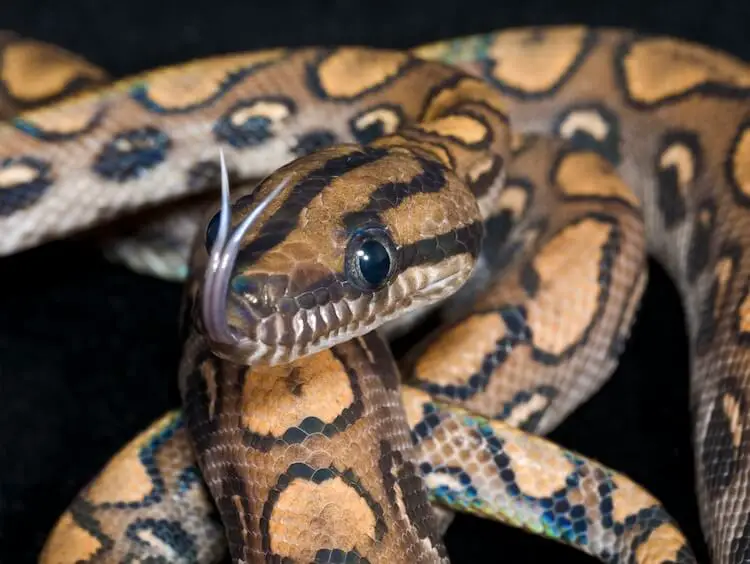
In the wild a Brazilian Boa will eat birds, fowl (and their chicks), as well as small-mammals such as bats and rodents. They kill their prey by piercing it with their small curved teeth and then strangling it. On a rarer occasion, they will attempt to swallow a bird’s egg, which they cannot digest and will regurgitate.
They are known to eat about once a week in captivity and they are not entirely fussy about what they eat!
As they age you should reduce their frequency of feeding. At adult size you can reduce feedings to once a fortnight before monthly feeding after a few years.
Baby boas can start eating pinky mice 5-10 days after birth, and, as they grow, will gradually start eating larger prey. Adult Brazilian Rainbow Boas will eat one or two rats in a single feeding. This will depend on their size and current body-condition:
- Females are typically bigger than males and enjoy eating rats
- Males, however, have more trouble digesting rats, and mice are the better choice
Freshly thawed mice or rats is the best option for feeding.
Excess food should be spot cleaned as needed and you should watch for any regurgitation of food, as this can indicate a digestive problem (more on this in the health section).
Your Brazilian Rainbow Boa should always have access to clean water in a shallow dish as they like to “hide” in their dish. This water dish should be large enough for them to soak in for long periods of time.
| Diet Summary | |
|---|---|
| Fruits | 0% of diet |
| Insects | 0% of diet |
| Meat | 100% of diet – small/medium sized rodents |
| Supplements Required | N/A |
Common Health Issues
A Brazilian Rainbow Boa will be very healthy in captivity with good husbandry!
Many problems arise for this snake if they are living in low humidity. They thrive in high-humidity environments, and a dehydrated boa will have indented scales. Make sure they have access to clean water and that the tank is misted regularly.
Another health issue that arises from poor husbandry is obesity or emaciation. To avoid this, you must feed rodents that are the appropriate size for your boa. Carefully monitor the size of your snake to determine if what you are feeding is too much or too little.
Finally, a common health problem with females is dystocia during birth.
This is a term used to describe general complications with birth, but more specifically is used to describe when the young are in the wrong position. If the boa has a coelomic mass, this may be an indication of an issue and needs to be treated with surgery.
How Long Do Rainbow Boas Live?
The Brazilian Rainbow Boa may live about 10 years in the wild, but can live up to 20 years in captivity if they receive correct and frequent husbandry.
Tank Cleaning
Misting should be done daily, especially if the air is dry in your household. The cage should be spot-cleaned daily (i.e. removal of waste and food as needed) and deep-cleaned on a month (e.g. complete clean and substrate change).
Make sure to remove your snake from their terrarium before deep-cleaning and put them safely somewhere else for a short period of time. If you have newspaper substrate, it should be a fairly quick and easy cleanup.
Feces should always be brown. They may have some undigested rodent parts in them (such as fur). This is okay if it happens occasionally and your boa is otherwise acting normally, but if your boa acts sick and this persists, it may be a sign of digestive problems. Use the table below to understand healthy and sickness symptoms:
| Signs They Are Healthy | Sickness Symptoms |
|---|---|
| Eating normally, likely at night | Noticeably under or overweight |
| Hiding, being solitary | Regurgitating food |
| Shy when being handled | Doesn’t struggle when being handled |
Are Rainbow Boas Aggressive?
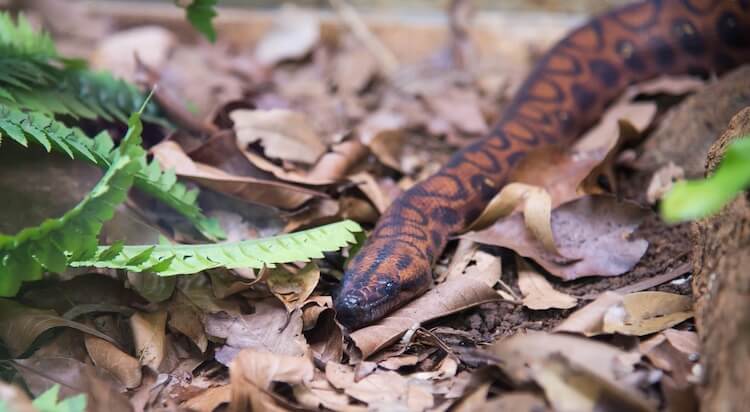
Rainbow Boas are solitary snakes that prefer to avoid interaction with one-another and other species of snake.
They only come together during the breeding season where males will fight each-other over females. They will wrap around each other and exert pressure until one of them gives in; dominance and challenging behavior can also be seen through tongue flicking.
When one submits, they will put their head on the ground and move away from the dominant boa. These boas will otherwise avoid each other, and have limited communication with each other. Some may defend themselves by striking out in anger.
In captivity, the Brazilian Rainbow Boa will be similarly reclusive. They should also be the sole resident of their enclosure, as they rarely interact with each other in the wild.
They will spend their time hiding in a log or shoe box, or whatever you have provided for them to curl up in.
Handling Advice
Some will tolerate handling more than others – especially older snakes.
In general they are not a big fan of handling and may attempt to bite. Typically after two years of age they begin to calm and are easier to handle.
They should be handled as infrequently as possible, so the only reason to attempt handling is to check their health and to clean their terrarium.
Brazilian Rainbow Boas are not venomous however juveniles are likely to bite or strike out. Wearing thick leather gloves will help to offer some protection against this when your snake is young.
As they age it is not recommended to wear gloves because it helps them learn your scent and associate you with not being a threat.
You should make sure all of your snake’s body weight is supported, and you should also hold them directly behind their head to avoid being bitten. They have small curved teeth and are able to pierce gloves.
Appearance
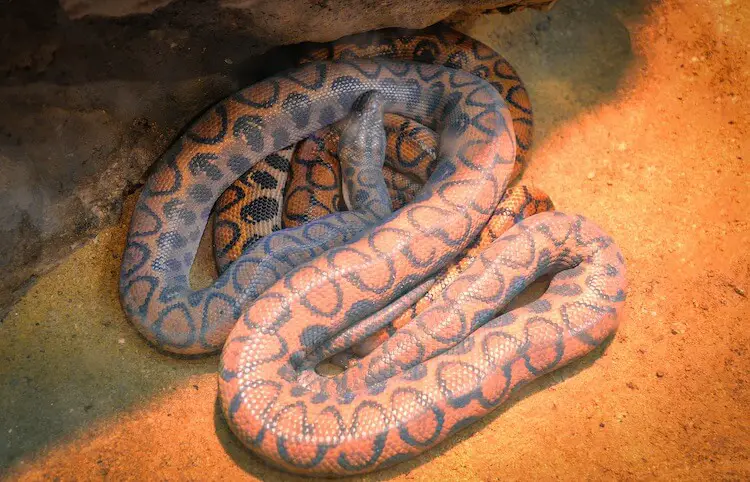
There are many subspecies of Epicrates cenchria with the E. c. cenchria being the most bred in captivity. The Brazilian Rainbow Boa has distinctive stripes and a rainbow shine which is what the species is best known for.
They vary from orange to a deep red, and they may have silver-gray sides. Their patterns may consist of solid black spots or stripes, or peacock-like spots. Young boas have the same patterns but tend to be lighter in color, and they will achieve their final color by two years old.
Most importantly, they are highly iridescent, especially after they shed. Their scales produce a “rainbow-like hue” when they shed. These boas shed for the first time 10 days after birth, and they slough to three to four times a year thereafter.
How Big Do Rainbow Boas Get?
Baby Boas are born about 15 – 20 inches long, and yearlings should have grown to 36 – 40 inches. Adults will be between 5 – 6.5 feet.
Females are more likely to grow to this length (this is the only obvious difference between genders). Slightly longer than the average pet snake, they are considered to be sexually mature when they are 5 feet long between 4 or 5 years old.
There is no extreme differentiation between males and females, other than that females tend to be longer.
Are Rainbow Boas Good Pets?
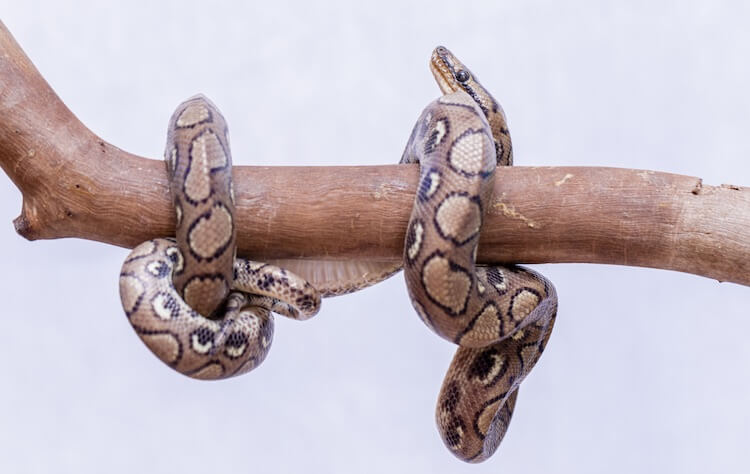
Brazilian Rainbow Boas are widely bred in captivity, and there are many breeders that have them. Make sure that the breeder has a good understanding of the health your snake and even their typical behavior and genetics.
They should know how to properly care for this species, including handling their temperamental behavior and high humidity requirement. The boa you purchase should be at a healthy size and be reluctant to be held.
How Much Does A Brazilian Rainbow Boa Cost?
Typically $200-$350 USD, with females typically on the more expensive side of that range. Albinos and boas with albino genetics will be a more expensive purchase ($1000 USD) and rare stripe boas command a larger premium again. The “candy stripe” or “picasso stripe” can sell for in excess of $2000 USD.
Baby Brazilian Rainbow Boas hatch inside of their mother and are born live, a trait termed oviviparous. They are about 15-20 inches in length at birth and will reach their set colors at two years old.
Sexual activity can be brought about by lowering the temperature of the tank to 68℉ (close to room temperature) for six weeks before introducing the snakes. Always bring the female to the male’s cage to avoid any aggressive behavior.
Breeders tend to mate their boas in January. The gestation period is usually five months, and they generally give birth in June or July. The neonates are born in a membrane that they must break out of after birth.
Care Guide Summary
| Why We Love Them | What Makes Them Difficult |
|---|---|
| Beautiful, unique color | High-humidity requirement |
| Easy to feed requiring | Shy and aggressive during handling |
| Simple husbandry requirements | Not for beginners |
The Brazilian Rainbow Boa is relatively easy to care for requiring minimal lighting, some heating, and a daily misting. They only eat once a week, and their diet consists of small rodents.
They are, however, not easy to handle when young and may bite. Because of this, they are not suited for beginner snake owners. Many beginners start with a Ball Python, or other more docile boas such as the Sand or Rosy.
This species is best known for its rainbow glow, and snake owners value them for the beauty that they possess.
They make a great addition to a home that needs a little color, and a great pet for a snake owner looking for a more challenging and eye-catching reptile. If this sounds like the one for you, prepare yourself to be the owner of one of the world’s most colorful snakes!
Already own one of these snakes? Let us know your experience below.

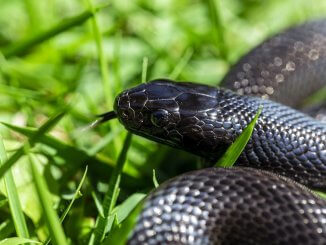
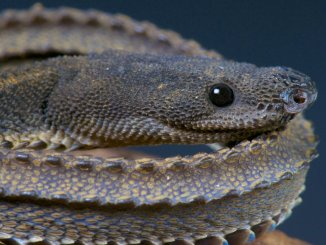
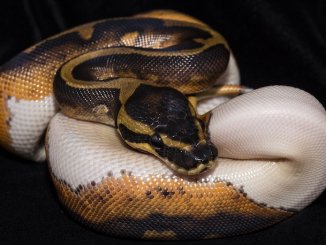

I have had my Brazilian Rainbow Boa for 14 years, since he was a 15″ baby. He’s been a wonderful pet. Always been healthy. I do watch his humidity levels and have two under tank heating pads. He loves to soak in his water bowl but does spend most of his time in his hide box. I use coconut substrate. I feed him in a separate feeding aquarium. He eats a large frozen /thawed rat every four to six weeks. He will only eat WHITE RATS though! I love handling him. His name is Mosby. He’s close to 7′ and very strong.
Hello, I was just wondering, by having a different feeding area, does this mean you carry them there? I mean you transfer the boa to that tank with the food inside it or you put the snake first before the food? Does it also have to get used to that feeding area first (like give it a few hours before giving the food in the first time it goes there or just place the snake carefully there and provide the food, leave it for 24hrs and then transfer it back to its usual tank?)
We have our Brazilian rainbow boa about 5 months now. My husband got him on an auction site. He was a baby when we got him. He bit my husband a few times lol so his name is Mr. Bitey lol. But we got him with a severe upper respiratory infection and mouth rot and didn’t know because we are new snake owners. We had to give him injections and he’s better now but he won’t eat. I think we have gotten him to eat maybe once a month since we have him. I’ve tried frozen and live. He’s very underweight and idk what else to do for him. Now since I had to nurture him when he was sick he’s loveable loves to be held and gives kisses 🥰 even fed him out my hand with a frozen pinky. I love him to pieces just wish I knew how to get him to eat.